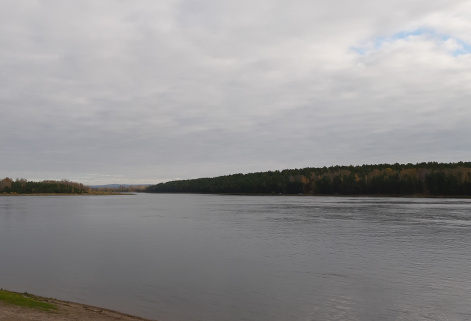Aquatic plants confirmed the reduction in the content of artificial radionuclides in the water of the Yenisei river
14 December 2020 г.

Contamination of natural water bodies with artificial radioactive elements is a serious environmental problem. For example, radionuclides in the Yenisei are due to the discharges of the plutonium production facilities at the Mining and Chemical Combine (MCC). The last nuclear reactor at the Mining and Chemical Combine was shut down in the spring of 2010, but according to official available reports from the Federal Service for Hydrometeorology and Environmental Monitoring, the radioactive discharges into the Yenisei continue in permissible amounts.
Scientists of the Federal Research Center "KSC SB RAS", using two species of aquatic plants, experimentally confirmed the decrease in the content of most technogenic radionuclides in aquatic plants of the Yenisei after the shutdown of the nuclear reactor at MCC. Almost all the previously detected radioactive isotopes, except for cesium-137, have disappeared or significantly reduced their concentrations in the biomass of the river plants.
Biologists examined long-term changes in the pollution of the Yenisei by radioactive substances from 2003 to 2018, i.e. during the operation of nuclear reactors and after their shutdown. To do this, they used two types of algae: shining pondweed (Potamogeton lucens) and water moss (Fontinalis antipyretica), which grow in abundance in the Yenisei. Scientists measured the content of radionuclides in the biomass of algae collected in different years and estimated the rate of a decline in their content. Aquatic plants are widely used as bioindicators which reflect the pollution of water and bottom sediments with various metals and radionuclides.
Having analyzed the long-term time series, the authors showed that the content of radionuclides in various types of aquatic plants reflects the amount of annual radioactive discharges into the Yenisei. The strength of the radionuclide binding to the plant biomass was also studied, which is necessary for estimating further transfer of radionuclides into the river. Radionuclides with a half-life of less than a year, isotopes of scandium, iron, cobalt and chromium were detected in samples of both plants in the period of 2003-2009, just during the operation of the nuclear reactor. Until 2011, radionuclides were recorded with a half-life of about a year, namely, zinc and manganese isotopes. Cobalt and europium were noted in samples until 2018, however, as scientists noted, the concentration of these substances has significantly decreased over the past 10 years.
The researchers also compared the accumulation efficiency of radionuclides between the two plant species. The study showed that the biomass of water moss contained several times more cobalt, cesium and europium than pondweed. Scientists associated this to a larger surface area and a longer life cycle of aquatic moss, as compared to pondweed. As a result, moss accumulates higher concentrations of artificial radionuclides. As the researchers say, this ability gives water moss an advantage as a potential “biomonitor “ of radioactive contamination of the Yenisei on a long-term scale, while shining pond will be more suitable for assessing the annual intake of radionuclides into the water body.
“Aquatic plants absorb well radionuclides from water; therefore, they are traditionally used for radioecological monitoring. At present, short-lived radionuclides formed in the core of a nuclear reactor are no longer registered in plants and fish inhabiting the Yenisei. Of the gamma emitters, only radiocesium is registered, which is still discharged to the Yenisei in the quantities allowed by the standards. The content of radiocesium in fish is significantly lower than the standards established in Russia. In this work, we have shown that plants reliably reflect the intake of technogenic radionuclides into the Yenisei; therefore, they can be used for regular radioecological monitoring on the Yenisei, which is as always relevant due to the development of nuclear industry enterprises, "says Tatyana Zotina, one of the authors of the article, Candidate of Biological Sciences, Senior Researcher at the Institute of Biophysics, SB RAS.
This research was supported by grants from the Russian Foundation for Basic Research and the Krasnoyarsk Regional Science Foundation (No. 18-44-240003).
Share:
